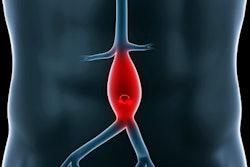
Will the U.S. Preventive Services Task Force (USPSTF) change its recommendations for abdominal aortic aneurysm (AAA) screening? It's too early to tell, but the task force published a draft research plan on August 10 to share its vision for how it will reassess the benefits and harms of ultrasound screening.
In its 2014 recommendations, the USPSTF retained its previous B-grade recommendation for one-time ultrasound screening for AAA in men ages 65 to 75 with a history of smoking. The USPSTF gave a C grade to men of this age group who have never smoked, reflecting its recommendation for selective screening. The task force also recommended against screening for women who have never smoked, noting that evidence was insufficient to assess the balance of benefits and harms of ultrasound screening for women ages 65 to 75 who have ever smoked.
With the new announcement, the USPSTF is opening the question up again. The task force is proposing an analytic framework for the draft research plan that seeks to address five questions:
- What are the effects of one-time screening for AAA on health outcomes in an asymptomatic population age 50 or older?
- Do the effects of one-time screening for AAA vary among subpopulations (i.e., by sex, smoking status, age, family history, or race/ethnicity)?
- What are the effects of rescreening for AAA on health outcomes or AAA incidence in a previously screened, asymptomatic population without AAA on initial screening?
- Do the effects of rescreening for AAA vary among subpopulations (i.e., by sex, smoking status, age, family history, or race/ethnicity)?
- Do the effects of rescreening for AAA vary by the time interval between screenings?
- What are the harms of one-time and repeated screening for AAA?
- What are the effects of treatment (pharmacotherapy or surgery) on treatment-relevant, intermediate health outcomes in an asymptomatic, screen-detected population with small AAAs (i.e., aortic diameter of 3.0 cm to 5.4 cm)?
- Do the effects of treatment vary among subpopulations (i.e., by sex, smoking status, age, family history, or race/ethnicity)?
- What are the harms of treatment in an asymptomatic, screen-detected population with small AAAs (i.e., aortic diameter of 3.0 to 5.4 cm)?
The task force also proposed three contextual questions that will not be systematically reviewed and aren't included in the analytic framework:
- Are there externally validated risk models for screening for AAA?
- Does the epidemiology or overall effectiveness of treatment of AAA differ by age, sex, smoking status, or family history?
- Does screening yield differ based on screening strategy (e.g., high-risk versus low-risk populations)?
Once finalized, the research plan will guide a systematic review by researchers at an evidence-based practice center, according to the USPSTF.
The full draft research plan can be found on the task force's website. Comments will be accepted until September 6 at 8:00 p.m. Eastern time.




















